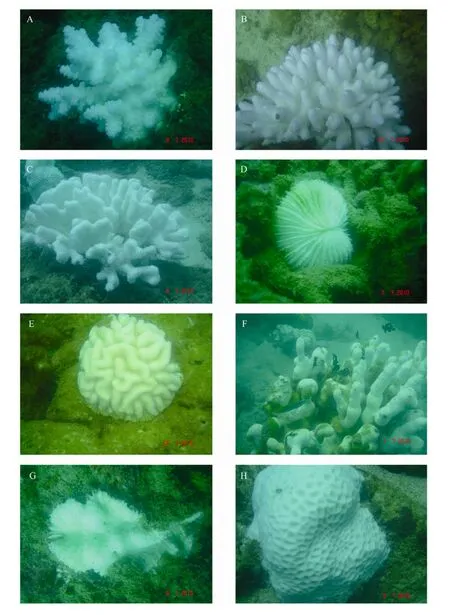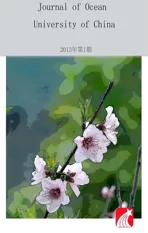Coral Reef Recovery Status in South Andaman Islands after the Bleaching Event 2010
2013-04-17MarimuthuJeraldWilsonNVinithkumarandKirubagaran
N.Marimuthu,J.Jerald WilsonN.V.Vinithkumarand R.Kirubagaran
1) Department of Marine Biology, Faculty of Marine Sciences, King Abdulaziz University, Jeddah 21589, Kingdom of Saudi Arabia
2) Andaman and Nicobar Centre for Ocean Science and Technology, National Institute of Ocean Technology(Ministry of Earth Sciences, Govt.of India), Dollygunj, Port Blair 744103, India
3) Marine Biotechnology, National Institute of Ocean Technology (Ministry of Earth Sciences,Govt.of India),Pallikaranai, Chennai 600100, India
1 Introduction
The Andaman and Nicobar (A and N) Islands in the eastern part of Bay of Bengal are heavily inhabited by corals.The coral reef ecosystem of the islands is endowed with fringing reefs where pristine and diverse organisms can be found.It consists of a chain of 572 islands stretching from Myanmar (Burma) in the North to Sumatra in the South (6˚–14˚N and 92˚–94˚E).The islands are one of the major coral reef ecosystems; it contains about 12000 km2of reef lagoons,coral banks,reef slopes and reef flat areas(Turneret al., 2001).The North and South Andaman are dominated byPoritessp.,while the Middle Andaman and Nicobar are dominated byAcroporasp.A total of 203 coral species are identified in the Islands (Turneret al.,2001).
Global warming caused by greenhouse gases has elevated both sea surface temperature (SST) and UV-B radiation.Marine biological communities most seriously affected by these changes are those near shoreline,on or close to sea surface (Wafar,1990).The most historically extreme El Niño Southern Oscillation (ENSO) event elevated SST of tropical oceans by more than 3℃.In India,the 1998 bleaching related mortality of organisms reached as high as 26% in Lakshadweep,23% in Gulf of Mannar(Arthur,2000) and 83% in Andaman Islands (Ravindranet al.,1999).In 2010,73% of the total corals in Lakshadweep Island bleached (Vinothet al., 2012).
The major objective of this study is to describe the recovery status of South Andaman reef ecosystem and to assess the stress induced by sedimentation.
2 Materials and Methods
The sessile benthic community of corals was estimated with line intercept transect (LIT) method (Englishet al.,1997).Twelve sites were chosen,of them 9 located in the Port Blair Zone namely North Bay (4),Ross Island (3)and Chidiyatappu (2) and 3 located in the Havelock Island Zone.These sites represented the reef flat and reef slope (Fig.1),which were marked with GARMIN e-Trex handheld GPS device for further monitoring.A 20-meters long flexible underwater tape was laid on the reefs roughly parallel to the shore with five replicates at each site (Fig.2A).The bleaching and post bleaching LIT data were collected in July 2010 and January 2011,respectively.The benthos coming under the transition points were recorded using international codes.The status of benthic forms during bleaching event and its corresponding recovery period (up to May 2011) were photographed using SONY DSC P100 equipped with underwater housing.

Fig.1 Study sites at South Andaman Islands.

Fig.2 Sediment trap model and line intercept transect method as described earlier (English et al., 1997) and sedimentation rate.A,Erected sediment trap in the coral reef environment of Port Blair Bay; B,Line intercept transect for biophysical status analysis; C,Sedimentation rate of Port Blair Bays (n = 3) recorded during the bleaching event of 2010.
The raw data collected were sorted and assessed using AIMS Reef Monitoring Data Entry System (ARMDES V1.6 Data Entry Program–Long term reef monitoring project,Australian Institute of Marine Sciences).The percentage cover was calculated for different life-forms in the reef ecosystem.The cumulative percentage of hard coral cover,algae and abiotic forms were also estimated using this package.
Sediment traps were custom-devised with the method described earlier (Englishet al., 1997),each contains 3 plastic containers that can measure 11.5 cm in height.Three sediment traps were placed in Port Blair Bay Zone to assess the sedimentation rate (Fig.2B).The accumulated sediments were analyzed monthly and expressed as sedimentation rate (mg cm-2d-1).
3 Results and Discussion
During the bleaching event of 2010,SST rose from 30.5℃ to 34℃ (April to May 2010) within the bays of Port Blair.The SST data (NOAA,2011) of National Environmental Satellite,Data,and Information Service(NESDIS) showed 1–2℃ increase above the normal at Andaman and Nicobar Islands from 1stApril to 24thMay,2010.During this period,coral species such asAcropora cerealis,A.humilis,Montiporasp.,Favia pallida,Diploastreasp.,Gonioporasp.Fungia concinna,Gardineroseriessp.,Poritessp.,Favites abditaandLobophylliarobustawere severely affected (Fig.3).This catastrophic bleaching and high SST were also reported in the nearby countries like Indonesia (Sukresno,2010) and Thailand(Klinthong and Yeemin,2011; Cook,2010).

Fig.3 Bleached coral colonies recorded at Port Blair Bay and Havelock Island in July 2010.A,Acropora cerealis Dana 1846; B,Acropora humilis Dana 1846; C,Pocillopora eydouxi Edwards and Haime 1860; D,Fungia danai Edwards and Haime 1851; E,Symphyllia sp.; F,Porites harrisoni Veron 2000; G,Oxypora crassisphosa Nemenzo 1979; H,Gardineroseries sp.
Sedimentation rate of Port Blair Bay is monitored at a monthly interval for another ongoing study.The sedimentation rate observed in this ongoing study was purposely correlated with that observed in present study in order to assess the impact of siltation during the recovery process if any (Fig.2C).In this study,the minimum sedimentation (0.27 mg cm-2d-1) was observed in November 2010,and the maximum (0.89 mg cm-2d-1) was observed in July 2010.The onset of south-west monsoon (highest rain fall of 600.2 mm) in July 2010 and resulting land runoff might be responsible for the highest sedimentation rate in the period (IMD,2010).In contrast,the lowest rate was observed during the post-monsoon period (October to November 2010).
About 77% of corals were bleached during July 2010 in Port Blair Bay and 21.1% of the corals were found recovered during January 2011 (Fig.4).Similarly,in Havelock Island,about 74% of corals were bleached during July 2010 and 13.29% of the corals were found recovered (Fig.4).In Port Blair Bay,dead coral with algae(DCA) and rubble cover increased up to 2.00% and 2.45%,respectively (Fig.4); whereas in Havelock Island the DCA and rubble cover were found increased up to 9.82% and 2.05%,respectively.

Fig.4 Comparison of bio-physical status of life-form categories between bleaching event of 2010 and postbleaching time.LC,live coral; BC,bleached coral; DCA,dead coral with algae; R,rubble; AA,algal assemblage;S,sand; OT,Others.
During the recovery period,new recruitment and rejuvenation were observed in common.Fig.5 shows the comparative bleaching and post bleaching status ofPorites harrisoni.Extended polyps were observed at all sites (Fig.6).The recovery of coral was instantaneous in the massive forms of all sites (Fig.6) includingDiploastrea heliopora,Goniopora somaliensis,G.minor,Porites harrisoni,Lobophyllia hemprichii,L.corymbosa,Symphyllia radians,S.recta,S.erythraea,Platygyra sinensis,P.verweyi,Diploria strigosa,Pavona decussate,Lithophyllon undulatum,Physogyra lichtensteini,Favites pentagona,Galaxea fascicularisandGoniastrea edwardsi.On the other hand,the branching forms likeAcropora aspera,A.cerealisandA.humiliswere severely damaged due to the bleaching impact.
Moreover,the elevated SST of the study sites might be due to delayed onset of southwest monsoon resulting in the prolonged summer period (IMD,2010).This unusual SST observed in the summer 2010 was reported in combination with El Niño followed by La Nina (Eakin,2010).There were three bleaching events reported (Kri- shnanet al., 2011) at A and N Islands in the years 1998,2002 and 2005 prior to current bleaching event.Similarly,the impact of 2002 bleaching and recovery of corals in the Palk Bay region was reported and its recovery was estimated as 57% within a three months period (Kumaraguruet al.,2003).Winteret al. (1998) compared 30 years records of SST with coral bleaching and accepted the intra- annual relationship between temperature and the incidence of bleaching.

Fig.5 A,Porites harrisoni Veron 2000 during bleaching(July 2010); B,Same coral observed post-bleaching(May 2011).

Fig.6 Recovered and partially recovered coral fauna observed during post-bleaching period.A,Diploastrea heliopora Lamarck 1816; B,Lobophyllia hemprichii Ehrenberg 1834; C,Pavona clavus Dana1846; D,Galaxea fascicularis Linnaeus,1767; E,Goniastrea retiformis; F,Goniopora sp.G,Ctenactis echinata Pallas 1766; H,Fungia sp.
Sedimentation rate is one of the factors which influence the coral bleaching and its simultaneous degradation.In Indian coastal region,numerous reports emerged on the impacts of sedimentation rate on coral reef ecosystem(Suresh,1991; Wilsonet al., 2005; Marimuthuet al.,2010).A comparative study indicated that the highest sedimentation rate observed in the Port Blair Bay was thirty four times less than that of the Gulf of Mannar region (30 mg cm-2d-1) (Marimuthuet al., 2010),and forty seven times less than that of the Palk Bay region (42 mg cm-2d-1) (Wilsonet al., 2005).Similarly,the minimum sedimentation rate was observed seven times less than that of the Gulf of Mannar (2 mg cm-2d-1) and three times less than that of the Palk Bay (1 mg cm-2d-1).Hence,the sedimentation rate observed in the Port Blair Bay was very minimal compared with the other Indian coastal regions such as Gulf of Mannar and Palk Bay.Thus the sedimentation rate observed in present study was insignificant.
Expulsion of associated zooxanthellae due to stress is known as bleaching.This expulsion may be of many reasons (Celliers and Schleyer,2002; Kumaraguruet al.,2003),and the majority of researchers denoted that the increase in SST will lead to the bleaching of corals (Baird and Marshall,1998; Arthur,2000; Kumaraguru,2000;Kumaraguruet al., 2003).Bleached corals require suitable environment with appropriate light condition and less sedimentation to recover (Pearson,1981; Marimuthuet al., 2011).The mean SST observed during the recovery study period (December 2010 to January 2011) was about 29.5℃ and the transparency recorded ranged from 8 to 10 m.NESDIS have shown that the SST was 1℃ lower than that of the normal during Dec.2010 at South Andaman Islands (NOAA,2011).Hence all these conditions were helpful for the recovery of the bleached species exceptAcroporasp.which was more vulnerable to natural impacts like El Niño and La Niña.
Acknowledgements
We are thankful to the Director of National Institute of Ocean Technology (NIOT),Chennai and the authorities of Ministry of Earth Sciences (Government of India) for providing necessary facilities and encouraging us to carry out this study.We also thank Mr.Dilip Kumar Jha for his help in preparing site map.
Arthur,R.,2000.Coral bleaching and mortality in three Indian reef regions during an El Niño Southern Oscillation event.Current Science, 79 (12): 1723-1728.
Baird,A.H.,and Marshall,P.A.,1998.Mass bleaching of corals of Great Barrier Reefs.Coral Reefs,17: 376.
Celliers,L.,and Schleyer,H.M.,2002.Coral bleaching on high-latitude marginal reefs at Sodwana Bay,South Africa.Marine Pollution Bulletin,44: 1380-1387.
Cook,N.,and Tao,E.K.,2010.Coral bleaching report.http://-www.coralwatch.org/c/document_library/get_file?uuid=899a 9fc0-215a-4386-a58e-adc88a378a9d&groupId=10136.
Eakin,M.,2010.2010 is bad year for coral reefs around the world.http://earthsky.org/biodiversity/mark-eakin-warmoceans-causing-worldwide-coral-bleaching-in-2010.
English,S.,Wilkinson,C.,and Baker,V.1997.Survey Manual for Tropical Marine Resource. Australian Institute of Marine Sciences,Townsville,Australia,390pp.
IMD,2010.Report on Rainfall Data for the Year2010. India Meteorological Department,Port Blair,India,12pp.
Klinthong,W.,and Yeemin,T.,2011.An analysis ofin situseawater temperature measurement at Similan Island during the 2010 coral bleaching event.37thCongress on Science and Technology of Thailand,Bangkok,Thailand,1-5.
Krishnan,P.,Roy,D.S.,George,G.,Srivastava,R.C.,Anand,A.,Murugesan,S.,Kaliyamoorthy,M.,Vikas,N.,and Soundararajan,R.,2011.Elevated sea surface temperature during May 2010 induces mass bleaching of corals in the Andaman.Current Science,100 (1):111-117.
Kumaraguru,A.K.,2000.Coral reefs in the Gulf of Mannar and the conservation strategies required.Ecology,Environment and Conservation,6 (1): 1-12.
Kumaraguru,A.K.,Jeyakumar,K.,and Ramakritinan,C.M.,2003.Coral bleaching 2002 in the Palkbay,Southeast Coast of India.Current Science,85 (12): 1787-1793.
Marimuthu,N.,Dharani,G.,Vinithkumar,N.V.,Vijayakumaran,M.,and Kirubagaran,R.,2011.Recovery status of sea anemones from bleaching event of 2010 in the Andaman waters.Current Science, 101 (6): 734-736.
Marimuthu,N.,Wilson,J.J.,and Kumaraguru,A.K.,2010.Reef status in the Mandapam group of Islands,Gulf of Mannar.Galaxea Journal of Coral Reef Studies,12 (2): 65-75.
NOAA.,2011.Report on Sea Surface Temperature Through National Environmental Satellite,Data and Information Service.http://www.ospd.noaa.gov/ml/ocean/sst/anomaly_2010.html.
Pearson,R.G.,1981.Recovery and recolonization of coral reefs.Marine Ecology Progressive Series,4: 105-122.
Ravindran,J.,Raghukumar,C.,and Raghukumar,S.,1999.Disease and stress-induced mortality of corals in Indian reefs and observations on bleaching of corals in the Andamans.Current Science, 76 (2): 233-237.
Sukresno,B.,2010.Empirical Orthogonal Functions (EOF)analysis of SST variability in Indonesian water concerning with ENSO and IOD.International Archives of the Photogrammetry,Remote Sensing and Spatial Information Science,38 (8): 116-121.
Suresh,V.R.,1991.Studies on the coral reefs of Lakshadweep.Ph.D.Thesis.Cochin University of Science and Technology,India.
Turner,J.R.,Vousden,D.,Klaus,R.,Satyanarayana,C.,Fenner,D.,Venkataraman,K.,Rajan,P.T.,and Subba Rao,N.V.,2001.Remote sensing and rapid site assessment survey.In:Coral Reef Systems of the Andaman Island.Government of India and United Nations Development Programme,Global Environment Facility,76pp.
Vinoth,R.,Gopi,M.,Thipramalai Kumar,T.T.A.,Thangaradjou,T.,and Balasubramanian,T.,2012.Coral reef bleaching at Agatti Island of Lakshadweep atolls,India.Journal of Ocean University of China, 11 (1): 105-110.
Wafar,M.V.M.,1990.Global warming and coral reefs.In:Sea Level Variation and Its Impact on Coastal Environment.Tamil University Publication,Tamilnadu,131: 411-432.
Wilson,J.J.,Marimuthu,N.,and Kumaraguru,A.K.,2005.Sedimentation of silt in the coral reef environment of southeast coast of India.Journal of Marine Biological Association of India,47 (1): 83-87.
Winter,A.,Appealdoorn,R.S.,Bruckner,A.,Williams,Jr.E.H.,Goenaga,C.,1998.Sea surface temperatures and coral reef bleaching off La Peraguera,Puerto Rico (Northern Caribbean Sea).Coral Reefs, 17: 377-382.
杂志排行
Journal of Ocean University of China的其它文章
- Optimization of the Purification Methods for Recovery of Recombinant Growth Hormone from Paralichthys olivaceus
- Growth,Metabolism and Physiological Response of the Sea Cucumber,Apostichopus japonicus Selenka During Periods of Inactivity
- Purification and Characterization of a New Thermostable κ-Carrageenase from the Marine Bacterium Pseudoalteromonas sp. QY203
- Seasonal Changes in Food Uptake by the Sea Cucumber Apostichopus japonicus in a Farm Pond: Evidence from C and N Stable Isotopes
- What Depth Should Deep-Sea Water be Pumped up from in the South China Sea for Medicinal Research?
- Chemical Characteristics and Anticoagulant Activities of Two Sulfated Polysaccharides from Enteromorpha linza(Chlorophyta)
